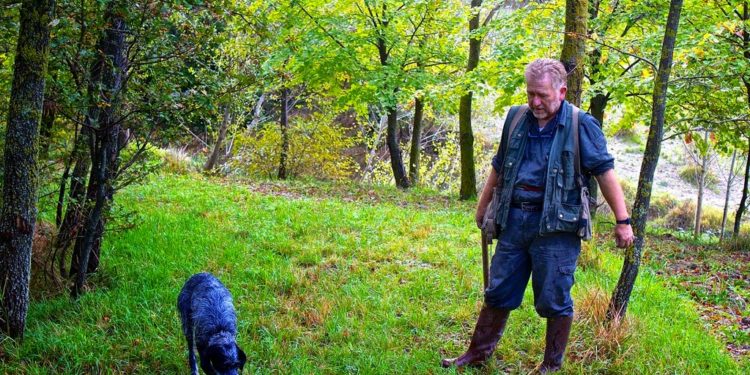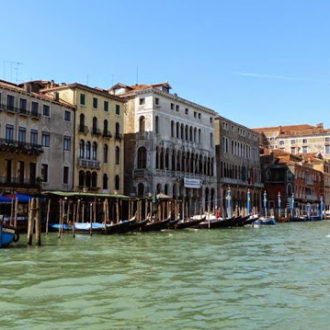
Hunt
trail of the elusive (and expensive) truffle in Le Marche, Italy
out Giorgio Remedia and the wiry grey hound bounds over, holding in her mouth what
looks like a black, misshapen potato the size of my fist. She drops it in
Remedia’s palm and holds open her mouth for a treat, before running off again.
One whiff of the musky scent and I know it’s no potato, rather the much-valued
black truffle.I am in Acqualagna, the truffle-hunting capital of Le Marche
region of central Italy.
pops into mind. This tiny town in Piedmont is famous for its prized white
truffles, and hosts the annual International Truffle Fair over six weeks in autumn.
However, truffles grow in most parts of Italy, and Acqualagna has a
particularly rich yield. “In Marche we have both black and white truffles; in
fact all nine types of edible truffles grow in these mountains”, says Mariano
Pallottini, ex-editor of Life Marche magazine, who accompanies me on the hunt.
Truffles grow
underground, and are a symbiotic mushroom relying on tree roots for nutrients.
They are usually found in thick woodlands, especially where there are many oaks
and poplars. Because they grow underground and cannot be detected by the human
eye (or nose), truffle hunters train dogs to do the work. “Initially pigs were
used for truffle hunting, but they are quite unruly and tend to eat the truffles
themselves”, says Remedia. He is a third generation truffle hunter and is generally
acknowledged as the best in Acqualagna, with several dogs that he has been
training since they were puppies.
an expert on finding truffles; in the hour I spent trudging behind Remedia and
Pallottini, she had dug up a dozen truffles of varying sizes. The previous
day’s rains had left the ground muddy, a perfect setting for truffle hunting, though
not very kind to my boots. Every time Chicca digs up a truffle, Remedia pats
the soil back in place. “Truffle spores remain in the soil and it’s important
to restore the environment so that development of truffles remains sustainable
year-on-year” explains Pallottini.
of 5,000 residents, Acqualagna seems like an unlikely location for the
multi-million-euro truffle business. Yet there are no less than 10 different
truffle industries here. Acqualagna Tartufi is one amongst them, a
thirty-year-old family-owned company that buys a large percentage of truffles
found in the region. Walking into the facility is like stepping into truffle paradise;
a pungent, earthy aroma fills the air and there are crates piled high with
truffles, waiting to be cleaned. “We sell some truffles to private buyers, but
a large quantity goes into making our truffle products, such as cream, oil and
sauces”, says Emaneula Bartolucci, the owner of Acqualagna Tartufi, as she
shows me around. In a market besieged with synthetically made truffle products
(a growing problem in Italy), Bartolucci takes pride in Acqualagna’s high
quality, preservative-free products; “it’s all chilometro zero (local)”, she smiles.
 |
| At Acqualagna Tartufi, with Emanuela Bartolucci. Image courtesy Mariano Pallottini |
Later that night, I
dig into a simple dish of buttered pasta, made decadent by a topping of
delicately shaved truffles. It’s the most expensive thing I have eaten; black
truffles can cost up to €2000 per kg (Rs. 136,000), while white truffles go for
as much as €5000 per kg (Rs. 341,000); well worth the price of one ruined pair
of boots, in my opinion!
(30 km from Acqualagna) is a restored farm estate, with a pool & spa, and a
celebrated chef in the kitchen. More details in a later post!
hosts three truffle fairs:
- The National White Truffle Fair – October-November
- The Regional Superior Black Truffle
Fair – the second to last Sunday of February - The Regional Summer Black Truffle Fair – first Sunday in August
Must Do:
- Go on a speleological exploration of the subterranean
Frasassi Caves - Trek up to Valadier’s Temple, a striking
octagonal church at the mouth of a mountain cave - Learn horseback riding at Urbino Resort
This story was commissioned by Vogue India. An edited version of this was published in the April 2015 Travel issue.









What do truffles taste like?
They have a pungent, earthy taste. Very heady! And you need a very small amount of truffle to appreciate its flavour 🙂
What an amazing experience to actually go truffle hunting! You should definitely try to make it to Alba one year for the Truffle festival there-the smell is just incredible!
Great info! I recently came across your blog and have been reading along. I thought I would leave my first comment. I don’t know what to say except that I have. Barnett Ghost 410 Review